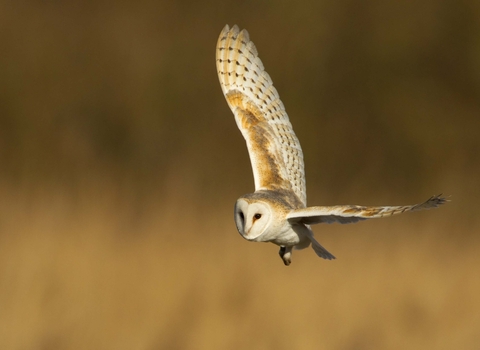
Barn owl ©Danny Green, 2020Vision

©Andy Rouse/2020VISION

©Jon Hawkins Surrey Hills Photography
Barn owl
Scientific name
Tyto albaWhen to see
January to DecemberSpecies information
Category
Statistics
Length: 33-39cmWingspan: 89cm
Weight: 300g
Average lifespan: 4 years
About
Perhaps our most familiar owl, the barn owl will sometimes hunt in the daytime and can be seen 'quartering' over farmland and grassland looking for its next small-mammal meal. However, it is perfectly adapted to hunt with deadly precision in the dark of night: combined with their stealthy and silent flight, their heart-shaped faces direct high-frequency sounds, enabling them to find mice and voles in the vegetation.How to identify
The barn owl has a mottled silver-grey and buff back, and a pure white underside. It has a distinctive heart-shaped, white face, and black eyes.Distribution
Widespread, but absent from the Highlands of Scotland and under threat in Northern Ireland.In our area
Barn owls have suffered declines over the last 50 years due partly to agricultural intensification and also habitat loss. Warwickshire Wildlife Trust is trying to halt this decline by engaging with farmers, landowners, other organisations and local people and by installing a network of Barn Owl nest boxes. The Arden Farm Wildlife Network, funded by Natural England’s Facilitation Fund was set up in April 2018 with the aim of supporting farmers to create bigger, better, more joined up areas that benefit wildlife. Farmers within the Network are committing to managing their land more sympathetically for barn owls, providing the right habitat for their food (small mammals) and creating corridors in the landscape for them to travel. The missing link is the availability of suitable nesting sites which will now be supported thanks to funding from Tesco Bags of Help.
The new network of Barn Owl nest boxes throughout the Arden landscape will enable the barn owl population to flourish. Barns Owls are site faithful and will stay in their home range for their whole lives so the nest boxes we're providing will help to maintain the Barn Owl population in Warwickshire for future generations. Looking after our Barn Owls means that many other small creatures and plants benefit as well.
Did you know?
Throughout history, barn owls have been known by many different nicknames, such as 'ghost owl', 'church owl' and 'screech owl'. But the name 'demon owl', in particular, illustrates how they were considered by some rural populations - something not so difficult to understand when you hear their piercing shrieks and hissing calls.Watch
Barn Owl by Russell Savory (https://vimeo.com/442049233)
Barn Owl by Russell Savory
Barn owls have suffered declines over the last 50 years due partly to agricultural intensification and also habitat loss. Warwickshire Wildlife Trust is trying to halt this decline by engaging with farmers, landowners, other organisations and local people and by installing a network of Barn Owl nest boxes. The Arden Farm Wildlife Network, funded by Natural England’s Facilitation Fund was set up in April 2018 with the aim of supporting farmers to create bigger, better, more joined up areas that benefit wildlife. Farmers within the Network are committing to managing their land more sympathetically for barn owls, providing the right habitat for their food (small mammals) and creating corridors in the landscape for them to travel. The missing link is the availability of suitable nesting sites which will now be supported thanks to funding from Tesco Bags of Help.
The new network of Barn Owl nest boxes throughout the Arden landscape will enable the barn owl population to flourish. Barns Owls are site faithful and will stay in their home range for their whole lives so the nest boxes we're providing will help to maintain the Barn Owl population in Warwickshire for future generations. Looking after our Barn Owls means that many other small creatures and plants benefit as well.
